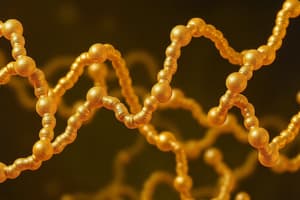Podcast
Questions and Answers
What are peptides?
What are peptides?
- Chains of lipids
- Short polymers of amino acids (correct)
- A chain of many amino acids
- Long chains of amino acids
What is the C-terminal residue in a peptide?
What is the C-terminal residue in a peptide?
- The residue with a free carboxyl group (correct)
- The amino-terminal residue
- The residue with a free -amino group
- The central residue
What is an oligopeptide?
What is an oligopeptide?
- A chain of many amino acids
- A chain containing three amino acids (correct)
- A chain containing only alanine
- A chain of lipids
What is a polypeptide?
What is a polypeptide?
How are amino acids linked in a peptide?
How are amino acids linked in a peptide?
Flashcards
What are peptides?
What are peptides?
Short chains of amino acids linked together by peptide bonds.
What is the C-terminal residue?
What is the C-terminal residue?
The amino acid at the end of a peptide chain with a free carboxyl group (-COOH).
What is an oligopeptide?
What is an oligopeptide?
A peptide chain containing three amino acids.
What is a polypeptide?
What is a polypeptide?
Signup and view all the flashcards
How are amino acids linked in a peptide?
How are amino acids linked in a peptide?
Signup and view all the flashcards
Study Notes
- Peptides are short chains of amino acids, while proteins are longer polymers made up of amino acids
- Amino acids in a peptide are linked together via peptide bonds
- Each amino acid residue in a peptide has an amino-terminal (N-terminal) with a free amino group and a carboxyl-terminal (C-terminal) with a free carboxyl group
- Peptides can range from 2 to 40 amino acids and are named or numbered starting from the amino terminus
- Amino acids can be joined by multiple peptide bonds to form oligopeptides (tripeptides, tetrapeptides, etc.) or a long chain of many amino acids called a polypeptide. Proteins contain one or more polypeptides.
- Peptide bond formation involves the removal of a water molecule and the formation of an amide linkage between the amino group of one amino acid and the carboxyl group of another.
- Amino acids can be represented with their three-letter or single-letter abbreviations, such as Trp (tryptophan), Ala (alanine), and Ser (serine)
- Peptides and proteins have specific structures, including primary, secondary, and tertiary structures, which determine their function in the body.
- Peptides and proteins play essential roles in various biological processes, such as enzyme activity, structural support, and signaling.
Studying That Suits You
Use AI to generate personalized quizzes and flashcards to suit your learning preferences.



